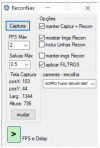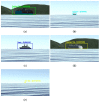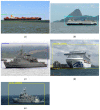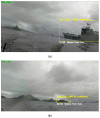An Augmented Reality Periscope for Submarines with Extended Visual Classification
- PMID: 34833700
- PMCID: PMC8622341
- DOI: 10.3390/s21227624
An Augmented Reality Periscope for Submarines with Extended Visual Classification
Abstract
Submarines are considered extremely strategic for any naval army due to their stealth capability. Periscopes are crucial sensors for these vessels, and emerging to the surface or periscope depth is required to identify visual contacts through this device. This maneuver has many procedures and usually has to be fast and agile to avoid exposure. This paper presents and implements a novel architecture for real submarine periscopes developed for future Brazilian naval fleet operations. Our system consists of a probe that is connected to the craft and carries a 360 camera. We project and take the images inside the vessel using traditional VR/XR devices. We also propose and implement an efficient computer vision-based MR technique to estimate and display detected vessels effectively and precisely. The vessel detection model is trained using synthetic images. So, we built and made available a dataset composed of 99,000 images. Finally, we also estimate distances of the classified elements, showing all the information in an AR-based interface. Although the probe is wired-connected, it allows for the vessel to stand in deep positions, reducing its exposure and introducing a new way for submarine maneuvers and operations. We validate our proposal through a user experience experiment using 19 experts in periscope operations.
Keywords: computer vision; deep learning; mixed reality; object detection; periscope; submarine; synthetic data; transfer learning.
Conflict of interest statement
The authors declare no conflict of interest.
Figures

















References
-
- Estado-Maior da Armada . EMA-305: Doutrina Militar Naval. Marinha do Brasil; Rio de Janeiro, Brazil: 2017. (In Portuguese)
-
- USS Key West at Periscope Depth. [(accessed on 19 August 2021)]. Available online: https://pt.m.wikipedia.org/wiki/Ficheiro:Periscope_Depth.jpg.
-
- BRASIL, Comando da Força de Submarinos . ComForS-730: Procedimentos Operativos Para Submarinos. Marinha do Brasil; Rio de Janeiro, Brazil: 2012. (In Portuguese)
-
- LeCun Y., Boser B., Denker J., Henderson D., Howard R., Hubbard W., Jackel L. Backpropagation applied to handwritten zip code recognition. Neural Comput. 1989;1:541–551. doi: 10.1162/neco.1989.1.4.541. - DOI
-
- Stanton N.A., Roberts A.P.J., Fay D.T. Up periscope: Understanding submarine command and control teamwork during a simulated return to periscope depth. Cogn. Technol. Work. 2017;19:399–417. doi: 10.1007/s10111-017-0413-7. - DOI
MeSH terms
LinkOut - more resources
Full Text Sources
Research Materials

